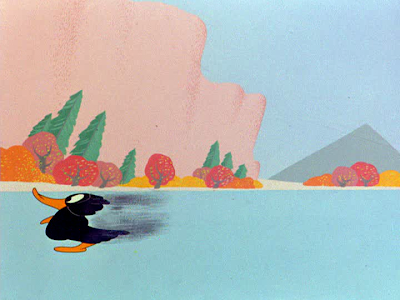If there’s one cartoon music composer who is derided, it’s Phil Scheib, responsible for scoring (and perhaps arranging) the music accompanying Heckle and Jeckle and all your other Terrytoons favourites.
Scheib didn’t have the luxury of a full symphony orchestra, like at Warners or MGM. He had the handicap of not being able to use music outside the public domain because producer Paul Terry wouldn’t pay for it. After a while, his scores started sounding pretty similar. Just as you could bet you’d hear the same splash sound effect that popped up in the last Terry cartoon you watched, you just knew a saxophone would be skipping around the scale during a chase scene.
It might leave you with the impression that Scheib was just another hack, but when Terry kissed off his cartoon studio for millions and CBS brought in Gene Deitch to produce, people (including Deitch) learned otherwise. Terry, Scheib told Deitch, was responsible for lacklustre scores he was forced to write, and proceeded to come up with musical material far more interesting.
Plenty has been written about Carl Stalling, who set the standard for cartoon scores. Scott Bradley has somewhat received his due. But little has been said about many of the others who worked on animated shorts in the ‘30s, ‘40s and ‘50s. We’ve posted about Van Beuren’s Gene Rodemich here, and now here’s a little biography of Scheib. It came from the
Mount Vernon Daily Argus of July 14, 1932. The writer’s crack about Tin Pan Alley shows she was more an aficionado of the classics as, apparently, was Scheib. You see to the right a radio listing for a local radio programme he did on Thursday nights in 1927. It certainly wasn’t dance band music.
Our Famous Neighbors
By ELISABETH CUSHMAN
The three young men who create and produce one of this country's best-loved "talkie" features, all live in Westchester. They are Paul Terry of Larchmont, Frank Moser of Hastings, and Philip Scheib of New Rochelle.
Of the three, "Phil" Scheib contributes the music.
He writes it by a stop-watch; it has to synchronize to a split second with the action of the picture; he writes it by the feet—and knows exactly how many feet of melody must be made to fit an equal number of feet of action. If there is any phase of this modern age which ilustrates [sic] perfectly the way in which music has become the hand-maid of the machine, it is in the production of the music for these "talkie" cartoons. That does not imply that it has also become servile but rather that even the great rattle and glamor of modern mechanics cannot get along without a musical setting and that music is adaptable to and fits in with every new development created by man.
Philip Scheib is not to be confused with one of the modern musical composers from Tin Pan Alley. He is a musician with a thorough and profound knowledge of his subject; he is a composer; and he is convinced that the "talkie" cartoon represents the most perfect coordination of the arts that the world has ever seen. It requires everything—play-writing, dialogue, verse, dancing and music. It is notable that in the 65 original scores he has written for the Terrytunes, there has never been a slip-up of a second in the synchronization of the music with the action.
He is 36 years old and a native of New York City. When he was scarcely more than a boy, he went to Germany to study music and shortly was convinced that his greatest field of usefulness rested in conducting. When he was 17 he received an honorary diploma from the Stern Conservatory of Music in Berlin, and when he came back to this country, the same year, it was as musical director for the famous operetta, "The Chocolate Soldier." For a period of years he directed a chain of ten theaters. He was musical director, also, for Adelaide and Hughes and travelled extensively with them.
The closing of so many theaters, the disbanding of so many orchestras, was one factor in his going into the movies and there he found a work sufficiently fascinating and with an interesting future to have engrossed him for the past several years. He wrote the score and theme song for D. W. Griffith's recent picture. "The Struggle," and holds the position of musical director for Griffith.
He lives at 891 Webster Avenue, New Rochelle, nearly opposite the Nature Woods. His small daughter, Barbara Ann, who has just learned to walk and to talk, gives every evidence of following in her father's foot-steps for she carries a tune with no difficulty at all and can sing through the nursery songs she has picked up from her mother. Barbara Ann is a blonde and pink baby, very much the kind one sees on magazine covers; she inherits her blondeness from her petite mother; her gifts from her father include not only what seems to be an unusual proclivity for things musical, but such a wealth of affection, intelligently controlled, as falls to the lot of few children. Philip Scheib worships his small daughter and thinks it a proud and lovely thing to talk of her. He has a direct and simple manner of speech, entirely disarming, with a quiet dignity that results in a personality the strength of which both men and women recognize. His heart is in his home and in his music and obviously he is making a success of both.
.png)
.png)
.png)
.png)
.png)
.png)
.png)
.png)
.png)
.png)


.png)
.png)
.png)
.png)
.png)

.png)
.png)
.png)
.png)
.png)
.png)
.png)
.png)






.png)
.png)
.png)
.png)
.png)
.png)
.png)
.png)
.png)
.png)
.png)
.png)
.png)
.png)
.png)
.png)
.png)
.png)
.png)
.png)